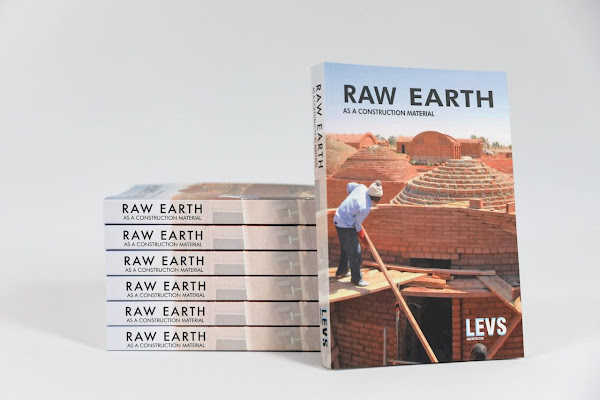Raw Earth as a Construction Material
Raw Earth as a Construction MaterialJurriaan van Stigt, Pietro Degli Esposti, Tea KufrinLEVS architecten, January 2021Paperback | 5-3/4 x 8-1/4 inches | 302 pages | English | ISBN: 978-9082694925 | 30€ARCHITECT'S DESCRIPTION:There is a big library with a lot of books on building with earth, rammed earth, building techniques etc. A lot of them are in French, some of them are English. Most of these publications are quite technical and based on European/Western standards and way of building and conceiving the built environment. The idea of the book is simple: to spread the knowledge of building with raw earth and with CEBs in a direct and understandable way. The main message is: ‘Learning by doing’.One of the first barriers in the use of earth is its negative connotation as a poor building material which must be refurbished after a short time. Over the last decades, CEBs technology has seen continuous substantial improvements. Thanks to this, today it is possible to demonstrate the grand potential of raw earth as a construction material and to allow more and more people to start building effectively with it.I believe that building with CEBs is a way to go today and for the future and this publication is just the start. I hope this book will be a useful tool for generations of students, architects, builders and any person dreaming of a better way of building and living in our environment. – Jurriaan van StigtdDAB COMMENTARY:When I think of buildings made with raw earth, I tend to picture walls of rammed earth. I'm not sure why that is: maybe it's the books I've read or the appeal of some contemporary buildings. Whatever the case, limiting considerations of earth architecture to rammed earth omits techniques that are more easily realized on a much wider scale. One such technique is CEBs, or compressed earth blocks, which are basically uniformly sized blocks made by compressing a humid earth mix in a manual or hydraulic press. They can be produced by the thousands every day with a crew of about a half-dozen and then stacked in walls with mortar, much like industrially produced bricks. Sounds easy enough, but there is a lot of technical criteria that should be followed in their construction, which Raw Earth as a Construction Material clearly explains.Raw Earth is self-published by LEVS architecten — available for purchase on their website — a Dutch firm that has a number of CEB projects on its website, most of them executed in Mali. Ten years ago, LEVS produced a booklet with some of their earthen projects built with local people and builders, an experience that led them to the conclusion that "there was an enormous need for training and education in building with earth." The new book provides lessons across eight chapters, most of them highly technical but also highly visual. It starts with the basics of raw earth and then moves on to soil testing and construction techniques before getting into CEBs in detail, with three chapters devoted to their production and construction.The biggest chapter, with 162 of the book's 302 pages, is "Building with CEBs," which literally builds upon the previous chapters that teach people how to select the proper earth mixes (first spread, below) and turn them into CEBs. "Building with CEBs" shows how to structure buildings made with the modular material: from the right foundation to their stacking/coursing, expansion joints, and openings, to vaults and domes also made with CEBs. Construction photographs accompanied by drawings, many of them axonometric (second through fourth spreads), make this chapter particularly helpful. The last two chapters of the book share some of the training workshops carried out by LEVS as well as some of their reference projects.Building with CEBs means building at a certain scale (one story, mainly), in certain compositions (symmetrical for even loading), and in certain forms (vaulted spaces more than flat roofs). Accordingly, even before jumping into the chapters, Hassan Fathy comes to mind. His classic book, Architecture for the Poor (1973), even appears on page 7, with a quote by the Egyptian architect: "Build your architecture from what is beneath your feet." Fathy's buildings appear in a few spots throughout the book, as if he is a spirit guiding LEVS in their quest to make CEBs more understandable and, in turn, more prevalent. As such, I can only hope that the people who learn from LEVS' experience in Mali apply their lessons to buildings all over the world.SPREADS:

Jurriaan van Stigt, Pietro Degli Esposti, Tea Kufrin
Paperback | 5-3/4 x 8-1/4 inches | 302 pages | English | ISBN: 978-9082694925 | 30€
ARCHITECT'S DESCRIPTION:
SPREADS:





